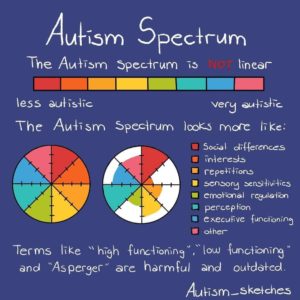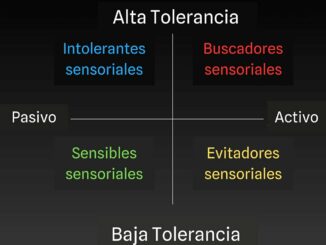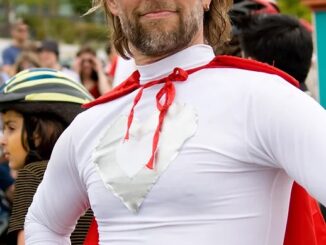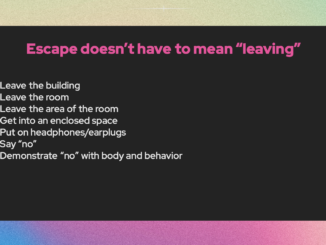Describing autism as a spectrum sometimes leads people to conceptualize it as though it is a single axis with “more autistic” and “less autistic” at the two polar ends of it, and each autistic person placed along this axis somewhere.
I’m going to go more in depth about autism classification later this month, but what I’m going to take a small essay to say, this comic says more concisely and much more cutely! https://the-art-of-autism.com/understanding-the-spectrum-a-comic-strip-explanation/?fbclid=IwAR1MjkzEfMAiPjChdchqYDLDOdxDAKE-o6-5-yAivgXtrOs8rofsPMwqL9c
The attached image by Autism Sketches also does a good job of showing it all in one image, though the comic strip linked above goes a little more in depth since it’s not all compressed into one image.
Basically: conceiving of the autism spectrum of one line from “less” to “more” autistic is not helpful. Rather, it may help to think of it as a circle with different categories. These categories might include things like: socializing/social differences, special interests, language differences, sensory processing style, emotional regulation, executive functioning skills, and other facets and co-occurring conditions as well. One Autistic person might have high needs in one area, but low needs in another area — or high skills in one area, but low skills in another area.

[Image description:
Dark blue background with white text over it that reads,
Autism Spectrum
The Autism spectrum is NOT linear.
(There is a rainbow-colored straight line segmented into different colors: Red, orange, light orange, yellow, green, teal, blue, pink. At left, it’s labeled “less autistic” and at right, it’s labeled “very autistic”.)
The Autism spectrum looks more like:
(There are two wheels, each rainbow-colored with the same colors as above, and with four notches on each wedge of the wheel. The wheel on the left is completely filled in with color. The wheel on the right shows each of the wedges as more or less filled in — for example, the orange wedge is only filled up to the first notch, but the teal and red wedges are filled entirely with color, and the rest are somewhere in-between. The colors are labeled out to the side with a key: Social differences, interests, repetitions, sensory sensitivities, emotional regulation, perception, executive functioning, and other.)
(The overall effect is to show that two different Autistic people on the “autism spectrum” could have very high skills or struggles in one area, but very low skills or struggles in a different area.)
Terms like “high functioning”, “low functioning”, and “Asperger” are harmful and outdated.
Autism Sketches
End description.]



